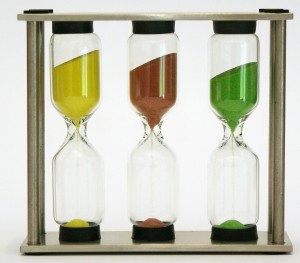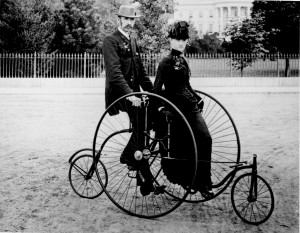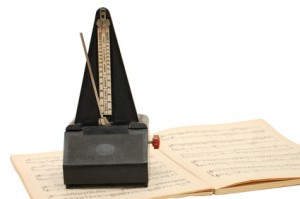 Continuously moving assembly lines can move as slow as they need to, to fit the work on the length of the line. However, they cannot be as fast as you like. There are some limitations on the speed of the line due to the limitations of the walking speed of a human worker, and even more so due to the ability of the worker to do work while the line moves. Let’s have a look!
Continuously moving assembly lines can move as slow as they need to, to fit the work on the length of the line. However, they cannot be as fast as you like. There are some limitations on the speed of the line due to the limitations of the walking speed of a human worker, and even more so due to the ability of the worker to do work while the line moves. Let’s have a look!
Speed
How Cheap Can You Make it?
 I was on a quest, a quest to find the cheapest ballpoint pen possible. And what I found was amazing. Modern manufacturing has achieved stunning productivity, where even a complex product like a ballpoint pen can be produced at costs that were unbelievable only a few decades ago. While everybody can make a pen, the goal in manufacturing is always to make it cheaper! For the same functionality, the customer will almost always go for the cheaper products. Let me show you the results of my quest.
I was on a quest, a quest to find the cheapest ballpoint pen possible. And what I found was amazing. Modern manufacturing has achieved stunning productivity, where even a complex product like a ballpoint pen can be produced at costs that were unbelievable only a few decades ago. While everybody can make a pen, the goal in manufacturing is always to make it cheaper! For the same functionality, the customer will almost always go for the cheaper products. Let me show you the results of my quest.
What Is Your Production Capacity?
 Your production capacity is one important aspect of your production system. The capacity has to match your demand. If your demand is higher than your capacity, then you will not be able to supply the customer. On the other hand, if your capacity is higher than the demand, then you will have lots of idle workers and machines, which is not good either. The name is actually a bit of a misnomer, since capacity is the ability to contain things, whereas for a production system we are much more interested in the number of parts that are completed. In any case, capacity is important!
Your production capacity is one important aspect of your production system. The capacity has to match your demand. If your demand is higher than your capacity, then you will not be able to supply the customer. On the other hand, if your capacity is higher than the demand, then you will have lots of idle workers and machines, which is not good either. The name is actually a bit of a misnomer, since capacity is the ability to contain things, whereas for a production system we are much more interested in the number of parts that are completed. In any case, capacity is important!
Cycle Times for Manual Processes

In my last two posts I described how to measure cycle times. However, for manual processes measuring cycle times is quite different, since the humans that are measured usually strongly dislike being measured. Therefore, it is difficult to measure it directly. There is an alternative to calculate it, but this also has lots of pitfalls. Let me explain you a bit about human psychology, and how to measure manual cycle times.
How to Measure Cycle Times – Part 2

This is the second post on how to measure the cycle time of a process. Again, the cycle time is the fastest repeatable time in which you can produce one part. Hence, as part of a series on manufacturing speed measurements I continue with more details on what cycle times really are. This is the second post on how to measure cycle times (post 1 here), with an additional third post focusing on the details of manual cycle times coming up next.
How to Measure Cycle Times – Part 1

The cycle time of a process is a key to match the supply with the demand in lean manufacturing. Everybody working on a shop floor knows the term. Yet, I still find that people sometimes confuse what exactly it means. The cycle time is the fastest repeatable time in which you can produce one part. Hence, in this post as part of a series on manufacturing speed measurements I would like to dig deeper into what cycle times really are, and how to best measure them. As it turns out, there is actually quite some detail on how to measure cycle times, hence I split this post into two parts (second part How to Measure Cycle Times – Part 2), with an additional third post focusing on the details of manual cycle times.
Pitfalls of Takt Times
 The customer takt (or takt time) is one of the fundamentals for determining the speed of a production system. After my post on How to determine Takt Times, this second post on takt times gives a bit of history, and then goes into more details about possible pitfalls and problems when calculating the customer takt. I also added an example for easier understanding.
The customer takt (or takt time) is one of the fundamentals for determining the speed of a production system. After my post on How to determine Takt Times, this second post on takt times gives a bit of history, and then goes into more details about possible pitfalls and problems when calculating the customer takt. I also added an example for easier understanding.
How to determine Takt Times

The customer takt (or takt time) is one of the fundamentals for determining the speed of a production system. It represents the available time divided by the average demand of the customer during that time. Effectively this is the average time between the order of one item. Whenever you design a new production system or change an existing system, one of the early data inputs you need is the customer takt. While the customer takt can be simply calculated by dividing the demand by the time available for production, there are many more details needed to understand it fully.
